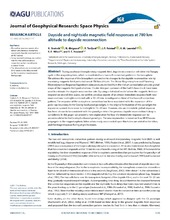| dc.contributor.author | Snekvik, Kristian | |
| dc.contributor.author | Østgaard, Nikolai | |
| dc.contributor.author | Tenfjord, Paul | |
| dc.contributor.author | Reistad, Jone Peter | |
| dc.contributor.author | Laundal, Karl Magnus | |
| dc.contributor.author | Milan, Stephen Eric | |
| dc.contributor.author | Haaland, Stein | |
| dc.date.accessioned | 2018-09-06T11:21:23Z | |
| dc.date.available | 2018-09-06T11:21:23Z | |
| dc.date.issued | 2017-02 | |
| dc.Published | Snekvik K, Østgaard N, Tenfjord PAR, Reistad JP, Laundal KM, Milan SE, Haaland SE. Dayside and nightside magnetic field responses at 780 km altitude to dayside reconnection. Journal of Geophysical Research - Space Physics. 2017;122(2):1670-1689 | eng |
| dc.identifier.issn | 2169-9402 | en_US |
| dc.identifier.issn | 2169-9380 | en_US |
| dc.identifier.uri | https://hdl.handle.net/1956/18417 | |
| dc.description.abstract | During southward interplanetary magnetic field, dayside reconnection will drive the Dungey cycle in the magnetosphere, which is manifested as a two‐cell convection pattern in the ionosphere. We address the response of the ionospheric convection to changes in the dayside reconnection rate by examining magnetic field perturbations at 780 km altitude. The Active Magnetosphere and Planetary Electrodynamics Response Experiment data products derived from the Iridium constellation provide global maps of the magnetic field perturbations. Cluster data just upstream of the Earth's bow shock have been used to estimate the dayside reconnection rate. By using a statistical model where the magnetic field can respond on several time scales, we confirm previous reports of an almost immediate response both near noon and near midnight combined with a 10–20 min reconfiguration time of the two‐cell convection pattern. The response of the ionospheric convection has been associated with the expansion of the polar cap boundary in the Cowley‐Lockwood paradigm. In the original formulation of this paradigm the expansion spreads from noon to midnight in 15–20 min. However, also an immediate global response has been shown to be consistent with the paradigm when the previous dayside reconnection history is considered. In this paper we present a new explanation for how the immediate response can be accommodated in the Cowley‐Lockwood paradigm. The new explanation is based on how MHD waves propagate in the magnetospheric lobes when newly reconnected open flux tubes are added to the lobes, and the magnetopause flaring angle increases. | en_US |
| dc.language.iso | eng | eng |
| dc.publisher | American Geophysical Union | en_US |
| dc.rights | Attribution CC BY-NC-ND | eng |
| dc.rights.uri | http://creativecommons.org/licenses/by-nc-nd/4.0/ | eng |
| dc.title | Dayside and nightside magnetic field responses at 780 km altitude to dayside reconnection | en_US |
| dc.type | Peer reviewed | |
| dc.type | Journal article | |
| dc.date.updated | 2018-03-05T13:39:38Z | |
| dc.description.version | publishedVersion | en_US |
| dc.rights.holder | Copyright 2017 The Author(s) | en_US |
| dc.identifier.doi | https://doi.org/10.1002/2016ja023177 | |
| dc.identifier.cristin | 1487868 | |
| dc.source.journal | Journal of Geophysical Research - Space Physics | |
| dc.relation.project | Norges forskningsråd: 230956 | |
| dc.relation.project | Norges forskningsråd: 223252 | |

